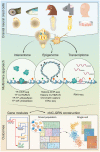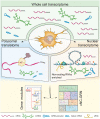The Cranial Neural Crest in a Multiomics Era
- PMID: 33732166
- PMCID: PMC7956944
- DOI: 10.3389/fphys.2021.634440
The Cranial Neural Crest in a Multiomics Era
Abstract
Neural crest ontogeny plays a prominent role in craniofacial development. In this Perspective article, we discuss recent advances to the understanding of mechanisms underlying the cranial neural crest gene regulatory network (cNC-GRN) stemming from omics-based studies. We briefly summarize how parallel considerations of transcriptome, interactome, and epigenome data significantly elaborated the roles of key players derived from pre-omics era studies. Furthermore, the growing cohort of cNC multiomics data revealed contribution of the non-coding genomic landscape. As technological improvements are constantly being developed, we reflect on key questions we are poised to address by taking advantage of the unique perspective a multiomics approach has to offer.
Keywords: epigenome; gene regulatory network; interactome; multiomics; neural crest; non-coding; transcriptome.
Copyright © 2021 Chong-Morrison and Sauka-Spengler.
Conflict of interest statement
The authors declare that the research was conducted in the absence of any commercial or financial relationships that could be construed as a potential conflict of interest.
Figures


Similar articles
-
Coupling the roles of Hox genes to regulatory networks patterning cranial neural crest.Dev Biol. 2018 Dec 1;444 Suppl 1:S67-S78. doi: 10.1016/j.ydbio.2018.03.016. Epub 2018 Mar 20. Dev Biol. 2018. PMID: 29571614 Review.
-
FGF8 signaling sustains progenitor status and multipotency of cranial neural crest-derived mesenchymal cells in vivo and in vitro.J Mol Cell Biol. 2015 Oct;7(5):441-54. doi: 10.1093/jmcb/mjv052. Epub 2015 Aug 4. J Mol Cell Biol. 2015. PMID: 26243590 Free PMC article.
-
p53 coordinates cranial neural crest cell growth and epithelial-mesenchymal transition/delamination processes.Development. 2011 May;138(9):1827-38. doi: 10.1242/dev.053645. Epub 2011 Mar 29. Development. 2011. PMID: 21447558
-
Cranial Neural Crest Cells and Their Role in the Pathogenesis of Craniofacial Anomalies and Coronal Craniosynostosis.J Dev Biol. 2020 Sep 9;8(3):18. doi: 10.3390/jdb8030018. J Dev Biol. 2020. PMID: 32916911 Free PMC article. Review.
-
Sox9 is required for determination of the chondrogenic cell lineage in the cranial neural crest.Proc Natl Acad Sci U S A. 2003 Aug 5;100(16):9360-5. doi: 10.1073/pnas.1631288100. Epub 2003 Jul 23. Proc Natl Acad Sci U S A. 2003. PMID: 12878728 Free PMC article.
Cited by
-
Cell Fate Decisions in the Neural Crest, from Pigment Cell to Neural Development.Int J Mol Sci. 2021 Dec 16;22(24):13531. doi: 10.3390/ijms222413531. Int J Mol Sci. 2021. PMID: 34948326 Free PMC article. Review.
-
Tfap2b specifies an embryonic melanocyte stem cell that retains adult multifate potential.Cell Rep. 2022 Jan 11;38(2):110234. doi: 10.1016/j.celrep.2021.110234. Cell Rep. 2022. PMID: 35021087 Free PMC article.
-
Glycan Epitope and Integrin Expression Dynamics Characterize Neural Crest Epithelial-to-Mesenchymal Transition (EMT) in Human Pluripotent Stem Cell Differentiation.Stem Cell Rev Rep. 2022 Dec;18(8):2952-2965. doi: 10.1007/s12015-022-10393-1. Epub 2022 Jun 21. Stem Cell Rev Rep. 2022. PMID: 35727432 Free PMC article.
-
Shaping faces: genetic and epigenetic control of craniofacial morphogenesis.Nat Rev Genet. 2023 Sep;24(9):610-626. doi: 10.1038/s41576-023-00594-w. Epub 2023 Apr 24. Nat Rev Genet. 2023. PMID: 37095271 Review.
-
Function of chromatin modifier Hmgn1 during neural crest and craniofacial development.Genesis. 2021 Oct;59(10):e23447. doi: 10.1002/dvg.23447. Epub 2021 Sep 3. Genesis. 2021. PMID: 34478234 Free PMC article.
References
Grants and funding
LinkOut - more resources
Full Text Sources
Other Literature Sources
Research Materials
Miscellaneous

